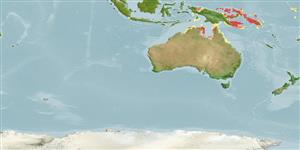>
Ovalentaria/misc (Various families in series Ovalentaria) >
Pomacentridae (Damselfishes) > Pomacentrinae
Etymology: Amphiprion: Greek, amphi = on both sides + Greek, prion, -onos = saw (Ref. 45335).
Environment: milieu / climate zone / depth range / distribution range
Ecologia
marino associati a barriera corallina; non migratori; distribuzione batimetrica 2 - 12 m (Ref. 9710). Tropical; 1°S - 25°S
Western Central Pacific: Papua New Guinea, Manus Islands, D'Entreceasteaux Islands, New Britain, and Solomon Islands.
Size / Peso / Age
Maturity: Lm ? range ? - ? cm
Max length : 12.0 cm TL maschio/sesso non determinato; (Ref. 90102)
Short description
Morfologia | Morfometria
Spine dorsali (totale): 9; Raggi dorsali molli (totale): 18-19; Spine anali 2; Raggi anali molli: 13 - 14.
Adults inhabit lagoons and outer reef slopes. Oviparous, distinct pairing during breeding (Ref. 205). Eggs are demersal and adhere to the substrate (Ref. 205). Males guard and aerate the eggs (Ref. 205). This species may be a hybrid between A. chrysopterus and A. sandaracinos. A. thiellei may be a similar hybrid (Ref. 90102). Associated with the anemones: Heteractis crispa, Heteractis magnifica, and Stichodactyla mertensii (Ref. 5911). Has been reared in captivity (Ref. 35420).
Life cycle and mating behavior
Maturità | Riproduzione | Deposizione | Uova | Fecundity | Larve
Oviparous, distinct pairing during breeding (Ref. 205). Eggs are demersal and adhere to the substrate (Ref. 205). Males guard and aerate the eggs (Ref. 205). Also Ref. 7471.
Allen, G.R., 1991. Damselfishes of the world. Mergus Publishers, Melle, Germany. 271 p. (Ref. 7247)
IUCN Red List Status (Ref. 130435)
Threat to humans
Harmless
Human uses
Warning: mysqli::__construct(): (HY000/1040): Too many connections in /var/www/html/includes/func_getlabel.php on line 46
Can't connect to MySQL database (fbapp). Errorcode: Too many connections
